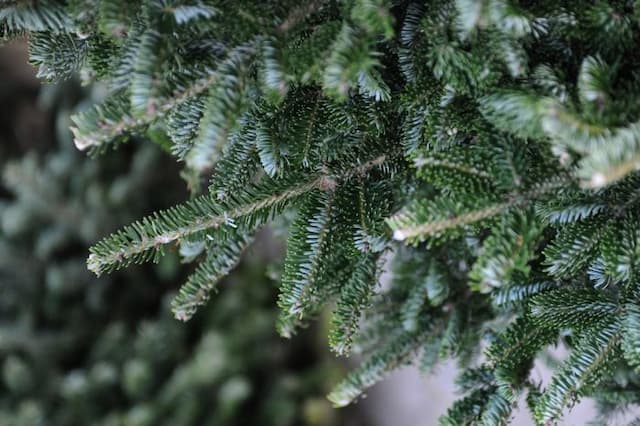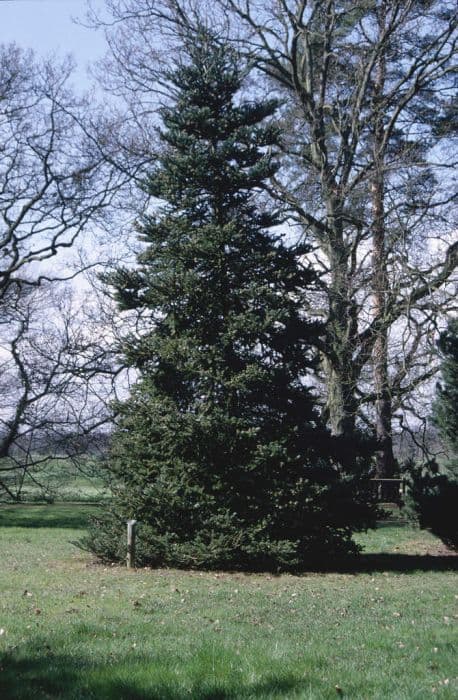Nordmann Fir Abies nordmanniana

ABOUT
The plant known as the Caucasian fir has a symmetrical, conical shape that gives it a classic Christmas tree appearance. Its branches grow horizontally from the central trunk and are densely packed with foliage, creating a full-bodied look often admired for ornamental purposes. The needles are notably shiny, dark green above and with two silver bands on the underside, giving a glimmering effect in the light. These needles are soft to the touch, unlike some other fir species, which can be prickly. The cones of the Caucasian fir are upright and cylindrical, with a color that matures from green to brown as they age. They add to the decorative aspect of the tree, providing visual interest even in the non-flowering season. The bark is smooth and gray when the tree is young, but it becomes rougher and more fissured with age. Overall, the Caucasian fir is a visually striking plant cherished for its aesthetic value and its ability to evoke a sense of the winter holidays.
About this plant
 Names
NamesFamily
Pinaceae
Synonyms
Nordmann Fir, Caucasian Fir, Turkish Fir
Common names
Abies nordmanniana subsp. nordmanniana, Abies nordmanniana var. equi-trojani, Abies nordmanniana var. cilicica, Pinus nordmanniana, Picea nordmanniana.
 Toxicity
ToxicityTo humans
The Nordmann fir is not considered toxic to humans. Consequently, ingesting its parts typically does not lead to poisoning or exhibit any harmful symptoms. However, as with many non-edible plants, it's advisable to avoid consumption as individual allergic reactions or gastrointestinal discomfort can occur.
To pets
The Nordmann fir is generally not toxic to pets. It is not known to cause poisoning in animals such as cats and dogs if they ingest the needles or other parts of the tree. However, the needles can be sharp and may cause irritation or discomfort in the mouth, throat, or stomach if ingested, potentially leading to digestive issues. It's still best to prevent pets from chewing on the plant.
 Characteristics
CharacteristicsLife cycle
Perennials
Foliage type
Evergreen
Color of leaves
Green
Height
50 60 feet (15 18 meters)
Spread
15 20 feet (4.5 6 meters)
Plant type
Tree
Hardiness zones
4 7
Native area
Caucasus Turkey
Benefits
 General Benefits
General Benefits- Ornamental Appeal: Abies nordmanniana, commonly known as Nordmann fir, exhibits a lush, symmetrical shape and rich green foliage, making it a popular choice for landscaping and gardens.
- Christmas Tree Choice: Due to its full, pyramidal shape, soft needles, and strong branches, the Nordmann fir is a favored species for Christmas trees.
- Shade Provider: The dense foliage offers ample shade, which can create a cooler microclimate beneath its canopy during hot summer months.
- Erosion Control: The extensive root system of Nordmann fir can help stabilize soil, reducing erosion on slopes and in areas prone to heavy rainfall.
- Habitat for Wildlife: It serves as a habitat for various species of birds and small mammals, providing shelter and a source of food through its seeds.
- Longevity: Nordmann fir is known for its long lifespan and can become a long-standing feature in a landscape if conditions are suitable.
- Low Maintenance: It requires relatively minimal upkeep once established, making it a convenient choice for those who desire an attractive yet undemanding tree.
- Sound Barrier: When planted in rows or groups, Nordmann fir can act as an effective sound barrier, reducing noise pollution from roads or neighbors.
- Privacy Hedge: As it can grow quite tall with dense foliage, the Nordmann fir is well-suited for privacy hedges or as a natural screen.
 Medical Properties
Medical PropertiesThis plant is not used for medical purposes.
 Air-purifying Qualities
Air-purifying QualitiesThis plant is not specifically known for air purifying qualities.
 Other Uses
Other Uses- Abies nordmanniana, commonly known as the Nordmann fir, is often used as a specimen tree in large gardens and parks for its aesthetic appeal.
- The wood of Nordmann fir is valuable for its resistance to rot and is used in construction for making indoor paneling and veneer.
- Due to its dense and pyramidal shape, Nordmann fir is used in shelterbelt plantings to protect against wind and erosion.
- The tree can be used in large-scale reforestation projects due to its adaptability and growth rate.
- Nordmann fir is popular in the Christmas tree industry for its symmetrical shape and ability to retain needles well after cutting.
- The resin from the Nordmann fir can be used in the production of turpentine and other resin products.
- Nordmann fir branches are sometimes used for wreaths and other holiday decorations outside of just being a traditional Christmas tree.
- Wood from the Nordmann fir is sometimes used to make boxes, crates, and pallets due to its strength and workability.
- Large plantation owners may utilize the Nordmann fir for timber crops, given its high-quality wood and demand in lumber markets.
- The tree is sometimes included in wildlife gardens or larger landscaping to provide habitat and shelter for birds and other animals.
Interesting Facts
 Feng Shui
Feng ShuiThe Nordmann fir is not used in Feng Shui practice.
 Zodiac Sign Compitability
Zodiac Sign CompitabilityThe Nordmann fir is not used in astrology practice.
 Plant Symbolism
Plant Symbolism- Longevity and Immortality: Abies nordmanniana, commonly known as the Nordmann fir, can live for hundreds of years, making it a symbol of long life and even immortality.
- Endurance and Resilience: As a species adapted to cold environments, the Nordmann fir is seen as an emblem of enduring harsh conditions and thriving in adversity.
- Festivity and Celebration: Being a popular Christmas tree, the Nordmann fir is often associated with holiday cheer, family gatherings, and the spirit of giving.
- Peace and Calm: The evergreen nature of this fir tree, its quiet and serene habitat in the forest, often symbolizes tranquility and the soothing presence of nature.
 Water
WaterThe Nordic Fir, or Nordmann Fir, should be watered regularly, especially during its growing season in the spring and summer. During these periods, aim to keep the soil consistently moist, providing about 1-2 inches of water weekly. Adjust the amount of water depending on rainfall, soil type, and climate conditions. In winter, reduce watering as the tree's growth slows down, ensuring that the soil doesn't become waterlogged.
 Light
LightThe Nordmann Fir thrives in full sun to partial shade. It is best to place it in a spot where it can receive at least six hours of direct sunlight daily. This tree prefers bright light conditions but can tolerate some shade, especially in hotter climates.
 Temperature
TemperatureThe Nordmann Fir is a hardy tree, tolerating a wide range of temperatures from as low as -40°F to as high as 90°F. However, its ideal growing temperatures are between 60°F and 75°F. These trees are well-suited to cooler climates and may struggle in hot, sustained temperatures above 80°F.
 Pruning
PruningThe Nordmann Fir generally requires little pruning other than to shape the tree or remove any damaged or diseased branches. Pruning is best done in late winter or early spring before new growth starts. Prune sparingly, as these trees do not readily regenerate from old wood.
 Cleaning
CleaningNot needed
 Soil
SoilNordic fir, or Abies nordmanniana, thrive in well-draining, moist soil with a slightly acidic to neutral pH, typically between 5.5 and 7.0. A good mix for these firs would include peat moss, compost, and sand or perlite to enhance drainage and aeration.
 Repotting
RepottingFor young Nordic fir trees, repotting is often necessary every few years to accommodate their growth. However, as they mature and their growth rate slows, repotting can be done less frequently, only when the tree becomes root-bound.
 Humidity & Misting
Humidity & MistingThe Nordic fir benefits from moderate to high humidity levels. They naturally grow in humid environments, so aim to replicate conditions with at least 50% humidity, avoiding extremely dry air.
 Suitable locations
Suitable locationsIndoor
Grow Nordic fir in bright, indirect light indoors, ensuring high humidity.
Outdoor
Plant Nordic fir in a sunny spot with moist, well-draining soil.
Hardiness zone
4-7 USDA
 Life cycle
Life cycleThe life of Nordmann fir (Abies nordmanniana) begins with seed germination, which typically occurs in the spring following a period of cold stratification that breaks the seed's dormancy. After germination, the seedlings establish themselves and grow into juvenile saplings, developing a strong root system and a straight stem. As a sapling, the Nordmann fir goes through a long period of vegetative growth, where it develops its characteristic conical shape and dense foliage. Upon reaching maturity, which can take several decades, the tree starts producing cones—male cones release pollen while female cones develop seeds after pollination. The mature trees can live for hundreds of years, during which they will annually produce cones and seeds, contributing to the regeneration of the species. Eventually, the tree reaches the end of its life cycle, dying from old age, disease, or environmental factors, and decomposes, returning nutrients to the soil and supporting the ecosystem.
 Propogation
PropogationPropogation time
Late winter
Propogation: The most popular method of propagation for the Abies nordmanniana, commonly known as the Nordmann fir, is through seeds. Typically, seed collection should occur from late summer to fall when the cones have matured yet have not opened and released their seeds. The seeds can be extracted from the cones by allowing the cones to dry in a warm environment, which causes them to open up and release the seeds. Once collected, the seeds benefit from a period of cold stratification at approximately 33-41 degrees Fahrenheit (0.5 to 5 degrees Celsius) for around one to two months to break dormancy and improve germination rates. After stratification, the seeds are sown in a well-draining soil mix and lightly covered. Seedlings require ample light and should be kept moist but not overly wet to prevent damping off. Successful seedlings are then gradually hardened off before being planted out in their permanent position.








